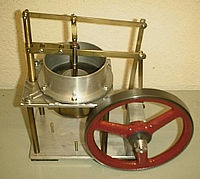
Photo from wikipedia
Abstract In order to develop machine learning methods for performance prediction of basic ORC (BORC) and regenerative ORC (RORC), thermodynamic properties of working fluids are used to separately model thermodynamic… Click to show full abstract
Abstract In order to develop machine learning methods for performance prediction of basic ORC (BORC) and regenerative ORC (RORC), thermodynamic properties of working fluids are used to separately model thermodynamic processes including compression, expansion, evaporation and regeneration by artificial neural network (ANN), based on REFPROP calculation data of 106 working fluids. These properties include critical temperature, critical pressure, acentric factor and ideal gas heat capacity. Other cycle performances can be derived from the predictions of established ANNs. Furthermore, for RORC, considering that dry or isentropic working fluid is usually preferred, vapor slope of temperature-entropy saturation curve is modeled by ANN to determine the working fluid behavior. Meanwhile, for ensuring occurrence of heat exchange in regenerator, temperature difference between outlets of turbine and pump is modeled to judge whether temperature difference is larger than the assumed pinch point temperature difference. Based on the obtained predictions for BORC, average absolute deviations (AADs) of net work and thermal efficiency are 1.3928% and 1.5461%, respectively. As for RORC, AADs of vapor slope, temperature difference, net work and thermal efficiency are 2.3659%, 1.2020% 1.8277% and 2.1047%, respectively. Based on the above models, cycle performances of BORC and RORC can be accurately predicted from thermodynamic properties of any working fluid.
Journal Title: Applied Thermal Engineering
Year Published: 2021
Link to full text (if available)
Share on Social Media: Sign Up to like & get
recommendations!